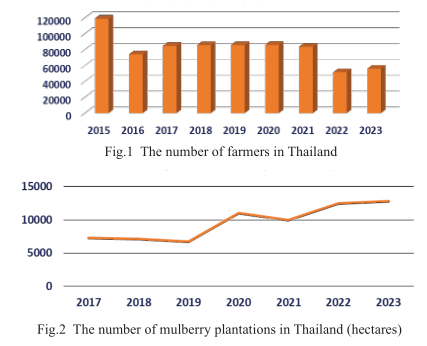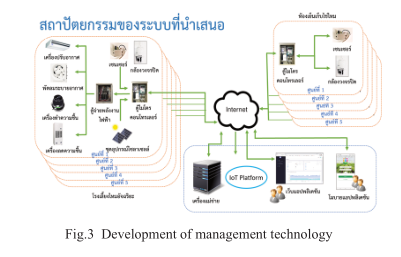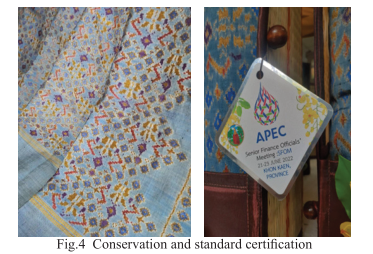Abstract: Sericulture in Thailand has a long history dating back more than 3000 years. Currently the number of farmers is approximately 57910 farmers, and the number of mulberry plantations is about 12850 hectares that are distributed in all the region of the country and 80% of them are located in the northeastern Thailand. According to the Thai Customs Department, in 2022, the production of raw silk yarn was 435 tons. Imports amount was $ 6279357, exports amount was $ 6284613. Major markets include the United States, Japan, Italy, the United Kingdom, and France. In addition, The Queen Sirikit Department of Sericulture (QSDS) has focused on research and development of technology and innovation in sericulture under the BCG (Bioeconomy, Circular Economy, Green Economy) model. The QSDS was established under the Ministry of Agriculture and Cooperatives, the development of Thai sericulture by QSDS includes 7 areas: (1) Mulberry and silkworm breeding; (2) Development of management technology;(3) Conservation standard certificate and environment; (4) The product development; (5) Promotion of supplementary occupations and related techniques; (6) Making contract farming system; (7) Cooperation with national and international community.
Introduction
Sericulture in Thailand has a long history dating back more than 3000 years. A piece of silk fabric was found on a prehistoric bronze bracelet that is 2400-3000 years old. In the present, the Queen Sirikit Department of Sericulture was established under the Ministry of Agriculture and Cooperatives. It is responsible for the overall mission of sericulture which consists of strategy and policy formulation, research and development, conservation and standard certification, technology transfer development and support and marketing to provide a better life for farmers.
1. Sericulture Situation
Currently the number of farmers is approximately 57910 farmers, and the number of mulberry plantations is about 12850 hectares that are distributed in all the region of the country and 80% of them are located in the northeastern Thailand. When we compared this number of farmers, the number is still less than previous year. So QSDS is working hard to increase the number of farmers coming back again.

According to the Thai Customs Department, in 2022, the production of raw silk yarn was 435 tons, which decreased 13.51% over the previous year. Imports amount was $ 6279357, which increased 48.57% compared with previous year. Exports amount was $ 6284613, which decreased 17.71% over the previous year. Major markets include the United States, Japan, Italy, the United Kingdom, and France.

In addition, The QSDS has focused on research and development of technology and innovation in sericulture under the BCG model.
2. Development in Thailand
2.1 Mulberry and silkworm breeding
Development of silk varieties in order to provide high yields of production as well as resistant to weather condition and any diseases, such as these two new silkworm varieties, NAN x J108 which is suitable for raising in winter; and J108 x Lahan Sai which is suitable for making silk blankets.
Developing mulberry varieties in order to produce high yields and resistant to diseases and insects such as, Sakon Nakhon 85 which has high resistant capacity for root rot disease, it can produce high leaf yield under rainfed condition. Sakon Nakhon has drought tolerant variety. It can produce leaf yield 26-28 tons/year/ hectare. Si Sa Ket 84 has high resistant capacity for rust disease.
2.2 Development of management technology
Using Arial Photograph, Satellite Imagery and Drone Technology to forecast and evaluate mulberry yields. Implementing the smart system to control and manage the silk raising rooms and egg storage rooms.

2.3 Conservation standard certificate and environment
The current number of mulberry varieties in conservation project are 227 varieties and the number of silkworms is 261 varieties. They were conserved in Gene bank and had researched and developed new varieties.
Besides, QSDS has many projects about environment, for example, project of Calculation for Carbon Sequestration, LCI data of handicraft sericulture products such as Mudmee Silk Shawl Kan Kaen Koon Pattern: received carbon label of the carbon footprint of product.

2.4 The product development
Silk is not only an exclusive fiber, but also provides us with valuable wastes and by-products such as spun silk yarns, sericin, pupae, and pupae oil.
2.5 Promotion of supplementary occupations and related techniques
In addition, we implemented the promotion of supplementary occupations and related techniques to provide the farmers with training materials and incentives. The result is not only increase the income of farmers but also upgrade Thai silk to meet the international standard.
2.6 Making contract farming system
We have a policy of “Marketing to lead production”, so, we try to make contract farming system, for example the prototype of Nan model.
2.7 Cooperation with national and international community
In addition, we have continued cooperation and academic exchange with the national and international community for the sustainable development of sericulture in the future.

